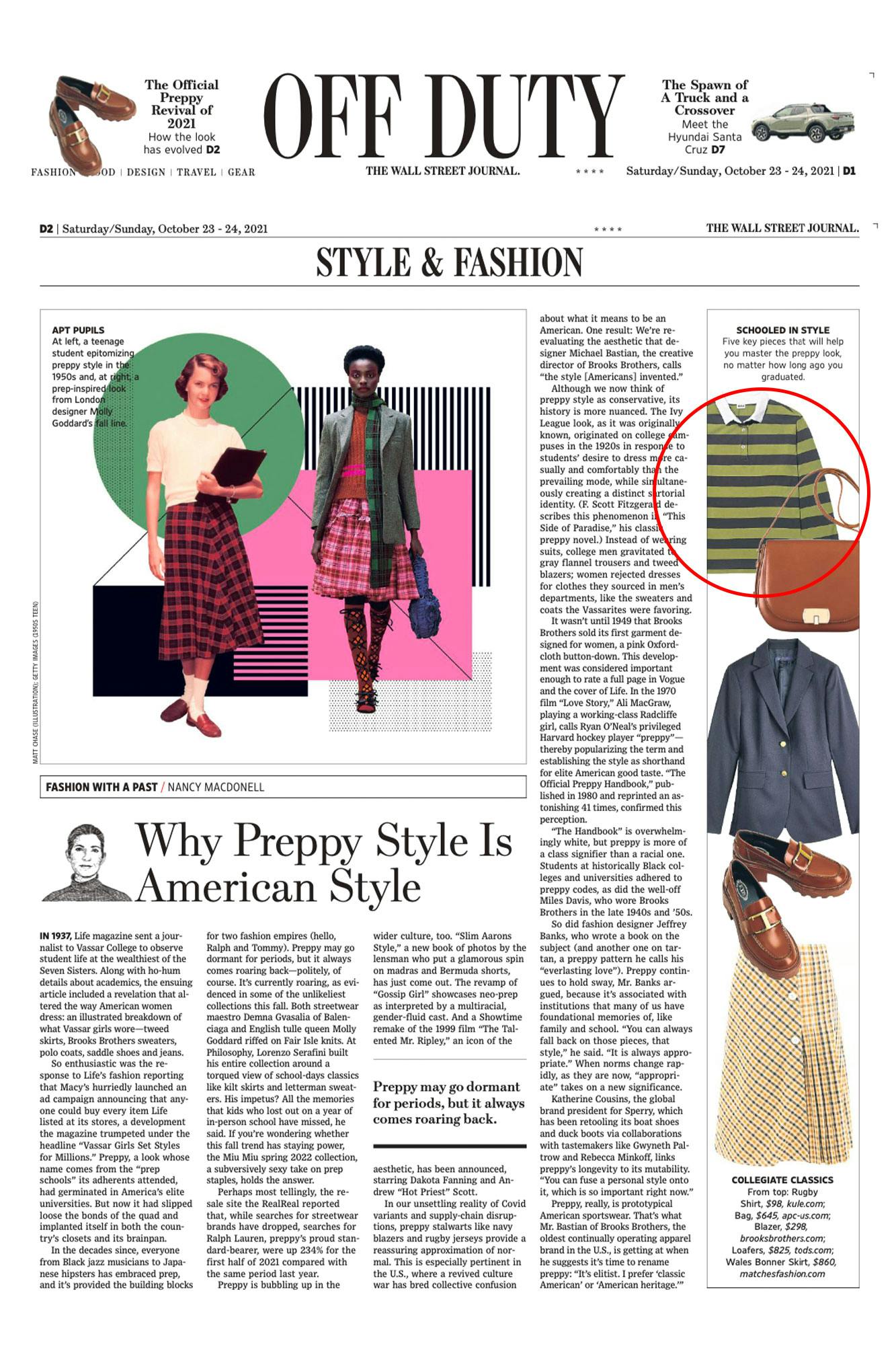Shop The Rugby.
Read more from The Wall Street Journal, WSJ Off Duty…
A History of Preppy Style: From the College Quad to the Runway
This classic look is trending again, populating European runways and stateside stores alike. Here, a primer on prep’s past and how to master what Brooks Brothers’ Michael Bastian calls ‘the style [Americans] invented.’
IN 1937, Life magazine sent a journalist to Vassar College to observe student life at the wealthiest of the Seven Sisters. Along with ho-hum details about academics, the ensuing article included a revelation that altered the way American women dress: an illustrated breakdown of what Vassar girls wore—tweed skirts, Brooks Brothers sweaters, polo coats, saddle shoes and jeans.
So enthusiastic was the response to Life’s fashion reporting that Macy’s hurriedly launched an ad campaign announcing that anyone could buy every item Life listed at its stores, a development the magazine trumpeted under the headline “Vassar Girls Set Styles for Millions.” Preppy, a look whose name comes from the “prep schools” its adherents attended, had germinated in America’s elite universities. But now it had slipped loose the bonds of the quad and implanted itself in both the country’s closets and its brainpan.
In the decades since, everyone from Black jazz musicians to Japanese hipsters has embraced prep, and it’s provided the building blocks for two fashion empires (hello, Ralph and Tommy). Preppy may go dormant for periods, but it always comes roaring back—politely, of course. It’s currently roaring, as evidenced in some of the unlikeliest collections this fall. Both streetwear maestro Demna Gvasalia of Balenciaga and English tulle queen Molly Goddard riffed on Fair Isle knits. At Philosophy, Lorenzo Serafini built his entire collection around a torqued view of school-days classics like kilt skirts and letterman sweaters. His impetus? All the memories that kids who lost out on a year of in-person school have missed, he said. If you’re wondering whether this fall trend has staying power, the Miu Miu spring 2022 collection, a subversively sexy take on prep staples, holds the answer.
Preppy may go dormant for periods, but it always comes roaring back.
Perhaps most tellingly, the resale site the RealReal reported that, while searches for streetwear brands have dropped, searches for Ralph Lauren, preppy’s proud standard-bearer, were up 234% for the first half of 2021 compared with the same period last year.
Preppy is bubbling up in the wider culture, too. “Slim Aarons Style,” a new book of photos by the lensman who put a glamorous spin on madras and Bermuda shorts, has just come out. The revamp of “Gossip Girl” showcases neo-prep as interpreted by a multiracial, gender-fluid cast. And a Showtime remake of the 1999 film “The Talented Mr. Ripley,” an icon of the aesthetic, has been announced, starring Dakota Fanning and Andrew “Hot Priest” Scott.
In our unsettling reality of Covid variants and supply-chain disruptions, preppy stalwarts like navy blazers and rugby jerseys provide a reassuring approximation of normal. This is especially pertinent in the U.S., where a revived culture war has bred collective confusion about what it means to be an American. One result: We’re re-evaluating the aesthetic that designer Michael Bastian, the creative director of Brooks Brothers, calls “the style [Americans] invented.”
Although we now think of preppy style as conservative, its history is more nuanced. The Ivy League look, as it was originally known, originated on college campuses in the 1920s in response to students’ desire to dress more casually and comfortably than the prevailing mode, while simultaneously creating a distinct sartorial identity. (F. Scott Fitzgerald describes this phenomenon in “This Side of Paradise,” his classic preppy novel.) Instead of wearing suits, college men gravitated to gray flannel trousers and tweed blazers; women rejected dresses for clothes they sourced in men’s departments, like the sweaters and coats the Vassarites were favoring.
It wasn’t until 1949 that Brooks Brothers sold its first garment designed for women, a pink Oxford-cloth button-down. This development was considered important enough to rate a full page in Vogue and the cover of Life. In the 1970 film “Love Story,” Ali MacGraw, playing a working-class Radcliffe girl, calls Ryan O’Neal’s privileged Harvard hockey player “preppy”—thereby popularizing the term and establishing the style as shorthand for elite American good taste. “The Official Preppy Handbook,” published in 1980 and reprinted an astonishing 41 times, confirmed this perception.
“The Handbook” is overwhelmingly white, but preppy is more of a class signifier than a racial one. Students at historically Black colleges and universities adhered to preppy codes, as did the well-off Miles Davis, who wore Brooks Brothers in the late 1940s and ’50s.
So did fashion designer Jeffrey Banks, who wrote a book on the subject (and another one on tartan, a preppy pattern he calls his “everlasting love”). Preppy continues to hold sway, Mr. Banks argued, because it’s associated with institutions that many of us have foundational memories of, like family and school. “You can always fall back on those pieces, that style,” he said. “It is always appropriate.” When norms change rapidly, as they are now, “appropriate” takes on a new significance.
Katherine Cousins, the global brand president for Sperry, which has been retooling its boat shoes and duck boots via collaborations with tastemakers like Gwyneth Paltrow and Rebecca Minkoff, links preppy’s longevity to its mutability. “You can fuse a personal style onto it, which is so important right now.”
Preppy, really, is prototypical American sportswear. That’s what Mr. Bastian of Brooks Brothers, the oldest continually operating apparel brand in the U.S., is getting at when he suggests it’s time to rename preppy: “It’s elitist. I prefer ‘classic American’ or ‘American heritage.’”
